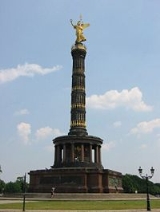
Berlin Victory Column
Encyclopedia
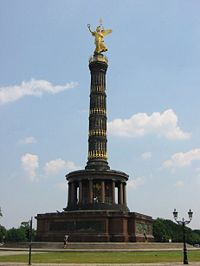


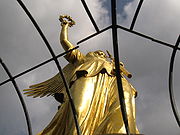
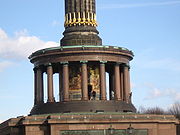
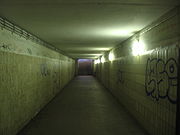
Berlin
Berlin is the capital city of Germany and is one of the 16 states of Germany. With a population of 3.45 million people, Berlin is Germany's largest city. It is the second most populous city proper and the seventh most populous urban area in the European Union...
, Germany
Germany
Germany , officially the Federal Republic of Germany , is a federal parliamentary republic in Europe. The country consists of 16 states while the capital and largest city is Berlin. Germany covers an area of 357,021 km2 and has a largely temperate seasonal climate...
. Designed by Heinrich Strack
Heinrich Strack
Johann Heinrich Strack was a German architect of the Schinkelschule. His notable works include the Berlin Victory Column.-Life:...
after 1864 to commemorate the Prussia
Prussia
Prussia was a German kingdom and historic state originating out of the Duchy of Prussia and the Margraviate of Brandenburg. For centuries, the House of Hohenzollern ruled Prussia, successfully expanding its size by way of an unusually well-organized and effective army. Prussia shaped the history...
n victory in the Danish-Prussian War, by the time it was inaugurated on 2 September 1873, Prussia had also defeated Austria in the Austro-Prussian War
Austro-Prussian War
The Austro-Prussian War was a war fought in 1866 between the German Confederation under the leadership of the Austrian Empire and its German allies on one side and the Kingdom of Prussia with its German allies and Italy on the...
(1866) and France in the Franco-Prussian War
Franco-Prussian War
The Franco-Prussian War or Franco-German War, often referred to in France as the 1870 War was a conflict between the Second French Empire and the Kingdom of Prussia. Prussia was aided by the North German Confederation, of which it was a member, and the South German states of Baden, Württemberg and...
(1870–71), giving the statue a new purpose. Different from the original plans, these later victories in the so-called unification wars
Unification of Germany
The formal unification of Germany into a politically and administratively integrated nation state officially occurred on 18 January 1871 at the Versailles Palace's Hall of Mirrors in France. Princes of the German states gathered there to proclaim Wilhelm of Prussia as Emperor Wilhelm of the German...
inspired the addition of the bronze sculpture of Victoria
Victoria (mythology)
In ancient Roman religion, Victoria was the personified goddess of victory. She is the Roman equivalent of the Greek goddess Nike, and was associated with Bellona. She was adapted from the Sabine agricultural goddess Vacuna and had a temple on the Palatine Hill...
, 8.3 metres high and weighing 35 tonnes, designed by Friedrich Drake
Friedrich Drake
Friedrich Drake was a German sculptor from Pyrmont.Drake studied under Christian Rauch. He executed numerous statues and busts, among others busts of Lorenz Oken, Leopold von Ranke, Otto von Bismarck and Helmuth von Moltke the Elder.Drake died in Berlin.-Works:* Victoria on top of the Berlin...
. Berliners, with their fondness for giving nicknames to buildings, call the statue Goldelse, meaning something like "Golden Lizzy".
The Victory Column is a major tourist attraction to the city of Berlin and opens daily: 9:30 a.m. – 6:30 p.m. (April – October), and 9:30 a.m. – 5:30 p.m. (November – March).
Design and dimensions
Built on a base of polished red granite, the column sits on a hall of pillars with a glass mosaic designed by Anton von Werner.The column itself consists of four solid blocks of sandstone, three of which are decorated by cannon barrels captured from the enemies of the aforementioned three wars. The fourth ring is decorated with golden garlands and was added in 1938–39 as the whole monument has been relocated. The fourth ring in the column has a meaning, similarly to the original 3 rings. The fourth ring was added by Hitler after the Battle of France
Battle of France
In the Second World War, the Battle of France was the German invasion of France and the Low Countries, beginning on 10 May 1940, which ended the Phoney War. The battle consisted of two main operations. In the first, Fall Gelb , German armoured units pushed through the Ardennes, to cut off and...
ended.
The relief decoration was removed at the request of the French forces in 1945, probably to prevent Germans from being reminded of former victories, especially the defeat of the French in 1871. It was restored for the 750th anniversary of Berlin in 1987 by the French president at that time, François Mitterrand
François Mitterrand
François Maurice Adrien Marie Mitterrand was the 21st President of the French Republic and ex officio Co-Prince of Andorra, serving from 1981 until 1995. He is the longest-serving President of France and, as leader of the Socialist Party, the only figure from the left so far elected President...
. However, several sections remain in France.
Designers and architects
Werner designed the original hall of pillars with a glass mosaic.The foundation is decorated with four bronze reliefs showing the three wars and the victorious marching of the troops into Berlin. They were created by
- Moritz SchulzMoritz SchulzMoritz Schulz was a German sculptor.-Biography:He studied at the Industrial School in Posen, at the Berlin Academy, and as a pupil of Friedrich Drake. From 1854 to 1870, he lived in Rome, studying the old masters and executing numerous works...
(1825–1904) - Karl Keil (1838–89)
- Alexander CalandrelliAlexander CalandrelliAlexander Emil Ludovico Calandrelli was a German sculptor of Italian descent.- Life :His father was a gem-cutter from Rome who came to Germany in 1832...
(1834–1903) - and Albert Wolff (1814–92)
Location and relocations
The Victory Column originally stood in Königsplatz (now Platz der Republik), at the end of the SiegesalleeSiegesallee
The Siegesallee was a broad boulevard in Berlin, Germany. About 750 m in length, it ran northwards through the Tiergarten park from Kemperplatz , to Königsplatz, in which stood the Berlin Victory Column, in its original position in front of the Reichstag The Siegesallee (German for "Victory...
(Victory Avenue). As part of the preparation of the monumental plans to redesign Berlin into Welthauptstadt Germania
Welthauptstadt Germania
Welthauptstadt Germania refers to the projected renewal of the German capital Berlin during the Nazi period, part of Adolf Hitler's vision for the future of Germany after the planned victory in World War II...
, in 1939, the Nazis
Nazi Germany
Nazi Germany , also known as the Third Reich , but officially called German Reich from 1933 to 1943 and Greater German Reich from 26 June 1943 onward, is the name commonly used to refer to the state of Germany from 1933 to 1945, when it was a totalitarian dictatorship ruled by...
relocated the column to its present site at the Großer Stern (Great Star), a large intersection on the city axis that leads from the former Berliner Stadtschloss
Berliner Stadtschloss
The Stadtschloss , was a royal palace in the centre of Berlin, capital of Germany. The palace bore features of the Baroque style, and its shape, finalized by the mid 18th century, is attributed to Andreas Schlüter, whose first design is likely to date from 1702, though the palace incorporated...
(Berlin City Palace) through the Brandenburg Gate
Brandenburg Gate
The Brandenburg Gate is a former city gate and one of the most well-known landmarks of Berlin and Germany. It is located west of the city centre at the junction of Unter den Linden and Ebertstraße, immediately west of the Pariser Platz. It is the only remaining gate of a series through which...
to the western parts of the city. At the same time, the column was augmented by another 7.5 metres, giving it its present height of 66.89 metres. The monument survived World War II
World War II
World War II, or the Second World War , was a global conflict lasting from 1939 to 1945, involving most of the world's nations—including all of the great powers—eventually forming two opposing military alliances: the Allies and the Axis...
without much damage. The relocation of the monument probably saved it from destruction, as its old site - in front of the Reichstag, at exactly 1500 metres, (one Roman mile), from the proposed new north-south triumphal way of the Nazis in line with the Imperial Victory Avenue
Siegesallee
The Siegesallee was a broad boulevard in Berlin, Germany. About 750 m in length, it ran northwards through the Tiergarten park from Kemperplatz , to Königsplatz, in which stood the Berlin Victory Column, in its original position in front of the Reichstag The Siegesallee (German for "Victory...
in the Tiergarten
Tiergarten
Tiergarten is a locality within the borough of Mitte, in central Berlin . Notable for the great and homonymous urban park, before German reunification, it was a part of West Berlin...
- was destroyed by American air raids in 1945. Without a British-American veto, the French would have dynamited the monument after the war.
Surrounded by a street circle
Traffic circle
A traffic circle or rotary is a type of circular intersection in which traffic must travel in one direction around a central island. In some countries, traffic entering the circle has the right-of-way and drivers in the circle must yield. In many other countries, traffic entering the circle must...
, the column is also accessible to pedestrians through four tunnels, built in 1941 to plans by Albert Speer
Albert Speer
Albert Speer, born Berthold Konrad Hermann Albert Speer, was a German architect who was, for a part of World War II, Minister of Armaments and War Production for the Third Reich. Speer was Adolf Hitler's chief architect before assuming ministerial office...
who likewise increased the width of the road between it and the Brandenburg Gate and designed the new Germania which was scheduled for construction after the victory obtained in the war. Via a steep spiral staircase of 285 steps, the physically fit may, for a fee, climb almost to the top of the column, to just under the statue and take-in the spectacular views over the Tiergarten
Tiergarten
Tiergarten is a locality within the borough of Mitte, in central Berlin . Notable for the great and homonymous urban park, before German reunification, it was a part of West Berlin...
including the Soviet War Memorial
Soviet War Memorial (Tiergarten)
The Soviet War Memorial is one of several war memorials in Berlin, capital city of Germany, erected by the Soviet Union to commemorate its war dead, particularly the 80,000 soldiers of the Soviet Armed Forces who died during the Battle of Berlin in April and May 1945.The memorial is located in the...
, 1946, in line with the Nazi proposed north-south triumphal way by Speer and Hitler.
Cultural references
Due to the statue atop of it the column was known as 'the tall woman' by Soviet troops who captured BerlinBattle of Berlin
The Battle of Berlin, designated the Berlin Strategic Offensive Operation by the Soviet Union, was the final major offensive of the European Theatre of World War II....
in 1945
The column is featured in Wim Wenders
Wim Wenders
Ernst Wilhelm "Wim" Wenders is a German film director, playwright, author, photographer and producer.-Early life:Wenders was born in Düsseldorf. He graduated from high school in Oberhausen in the Ruhr area. He then studied medicine and philosophy in Freiburg and Düsseldorf...
' film Wings of Desire
Wings of Desire
Wings of Desire is a 1987 Franco-German romantic fantasy film directed by Wim Wenders. The film is about invisible, immortal angels who populate Berlin and listen to the thoughts of the human inhabitants and comfort those who are in distress...
(1987) as being a place where angels congregate.
The Victory Column served as the location for Barack Obama
Barack Obama
Barack Hussein Obama II is the 44th and current President of the United States. He is the first African American to hold the office. Obama previously served as a United States Senator from Illinois, from January 2005 until he resigned following his victory in the 2008 presidential election.Born in...
's speech in Berlin during his visit to Germany on July 24, 2008. The choice of site was somewhat controversial as it symbolises German military victories of the past and is still seen by some as a Nazi symbol. In the 1989 film Das Spinnennetz
Spider's Web (film)
Spider's Web is a 1989 West German film directed by Bernhard Wicki. It is based on the eponymous 1923 novel by Joseph Roth. It was chosen as West Germany's official submission to the 62nd Academy Awards for Best Foreign Language Film, but did not manage to receive a nomination...
(directed by Bernhard Wicki, based on the fragmentary novel of the same name by Joseph Roth
Joseph Roth
Joseph Roth, born Moses Joseph Roth , was an Austrian journalist and novelist, best known for his family saga Radetzky March about the decline and fall of the Austro-Hungarian Empire, and for his novel of Jewish life, Job as well as the seminal essay 'Juden auf Wanderschaft' translated in...
), Ulrich Mühe
Ulrich Mühe
Friedrich Hans Ulrich Mühe was a German film, television and theatre actor. He played the role of Hauptmann Gerd Wiesler in the Oscar-winning film Das Leben der Anderen , for which he received the award for Best Performance by an Actor in a Leading Role, Gold, at Germany's most prestigious film...
as protagonist Leutnant Lohse partakes in a 1920s plot to bomb the Victory Column, but being a right-wing spy among the communist plotters, he foils their plans.
The golden statue atop the column was featured in the music video to U2
U2
U2 are an Irish rock band from Dublin. Formed in 1976, the group consists of Bono , The Edge , Adam Clayton , and Larry Mullen, Jr. . U2's early sound was rooted in post-punk but eventually grew to incorporate influences from many genres of popular music...
's 1993 "Stay (Faraway, So Close!)
Stay (Faraway, So Close!)
"Stay " is a song by the rock band U2. It is the fifth track on their 1993 album, Zooropa and was released as the album's third single on 22 November 1993. The song was a top ten hit in the Ireland, Australia, the United Kingdom, and several other countries. The music video was shot in Berlin,...
" and inspired Paul van Dyk
Paul van Dyk
Matthias Paul, better known by his stage name Paul van Dyk is a German Grammy Award-winning Electronic Dance Music DJ, musician and record producer...
's 1998 trance music
Trance music
Trance is a genre of electronic dance music that developed in the 1990s.:251 It is generally characterized by a tempo of between 125 and 150 bpm,:252 repeating melodic synthesizer phrases, and a musical form that builds up and breaks down throughout a track...
hit, "For an Angel"; the column was also featured in his music video during the Love Parade
Love Parade
The Love Parade was a popular electronic dance music festival and parade that originated in 1989 in West Berlin, Germany. It was held in Germany annually between 1989 and 2003 in Berlin, and then from 2006 to 2010 in the Ruhr region...
in 1998. "El Ángel
El Ángel
El Ángel de la Independencia , most commonly known by theshortened name El Ángel and officially known as Columna de la Independencia, is a victory column located on a roundabout over Paseo de la Reforma in downtown Mexico City.El Ángel was built to commemorate the centennial of the beginning of...
" in Mexico City
Mexico City
Mexico City is the Federal District , capital of Mexico and seat of the federal powers of the Mexican Union. It is a federal entity within Mexico which is not part of any one of the 31 Mexican states but belongs to the federation as a whole...
bears a more than passing resemblance to the Berlin victory column, while both echo the earlier examples of the victory column crowned by an angel, notably the Alexander Column
Alexander Column
The Alexander Column also known as Alexandrian Column , is the focal point of Palace Square in Saint Petersburg, Russia. The monument was erected after the Russian victory in the war with Napoleon's France...
in Saint Petersburg
Saint Petersburg
Saint Petersburg is a city and a federal subject of Russia located on the Neva River at the head of the Gulf of Finland on the Baltic Sea...
. In the 18th episode of "Ghost in the Shell
Ghost in the Shell
is a Japanese multimedia franchise composed of manga, animated films, anime series, video games and novels. It focuses on the activities of the counter-terrorist organization Public Security Section 9 in a futuristic, cyberpunk Japan ....
: Stand Alone Complex 2nd Gig", Batou is stationed on the monuments shoulder. it is here that Batou notices a young girl who talks to the statue, addressing it as "Angel." The Victory Column is meant to represents the girl's absent father, the episode's main criminal and multinational terrorist, Angel's Feathers.
The column also lends its name to a Berlin magazine for the LGBT community.

